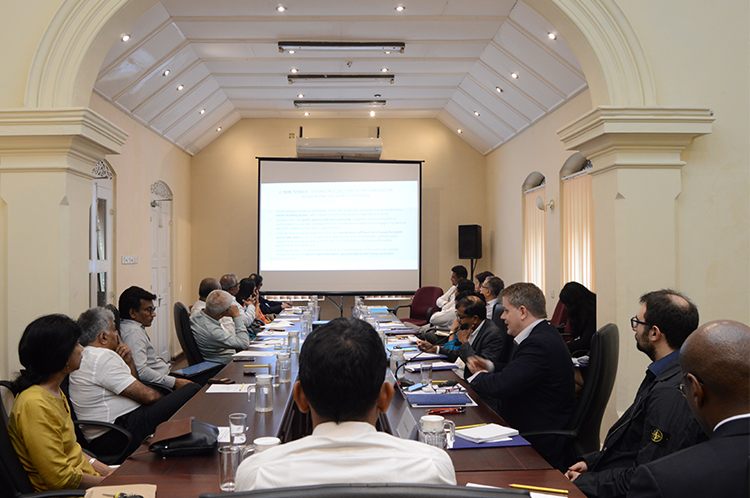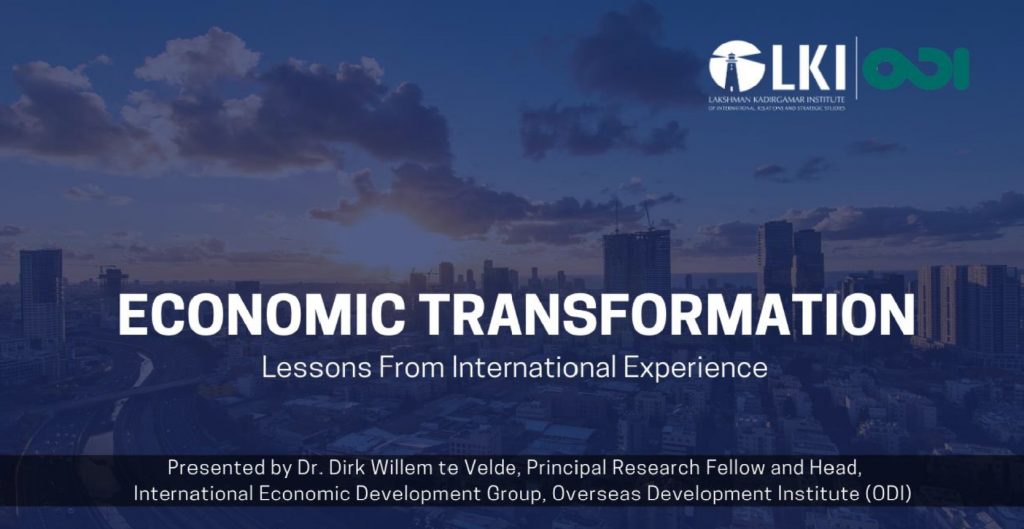Takeaways – Dr. Dirk Willem te Velde on ‘Economic Transformation – Lessons from International Experience’
February 5, 2020 Reading Time: 4 minutes

Reading Time: 4 min read
Three key takeaways from the round table discussion with Dr. Dirk Willem te Velde –
- Despite experiencing significant growth rates, some developing countries have not transformed structurally and therefore, have failed to diversify their production as well as exports and hence improve export competitiveness.
- Economic transformation relates to the shift of resources from lower to higher productivity activities to result in more diversified and complex productive activities. It is therefore essential for economic growth, job creation, and poverty reduction.
- Economic transformation pathways are supported by a combination of targeted public policies, a conducive set of rules, supporting institutions, healthy economic fundamentals, and private entrepreneurship.
Introduction
- Dr. Dirk Willem te Velde, Principal Research Fellow and Head of the International Economic Development Group at the Overseas Development Institute, addressed a Foreign Policy Round Table titled ‘Economic Transformation – Lessons from International Experience’ on 23 January 2020 at the Lakshman Kadirgamar Institute (LKI).
- The session was moderated by Dr. Ganeshan Wignaraja, Executive Director of LKI.
- The Round Table was attended by senior officials from the Ministry of Foreign Affairs and other government agencies, as well as senior representatives from academia, think tanks, and the private sector.
Takeaways from Dr. Dirk Willem te Velde’s Presentation:
- Plurilateral agreements will benefit Sri Lanka in the same manner that they have benefited other developing countries such as Chile and Vietnam.
- When negotiating trade agreements, Sri Lanka must present strong arguments related to flexibility and differential treatment.
Understanding Economic Transformation
- Higher quality and inclusive growth is key to alleviating poverty and enhancing productivity growth. This said, low-quality growth based on high commodity prices and increased debt levels, has been experienced in various countries in Sub Saharan Africa, leading to a decline in productivity.
- Korea and Ghana were at similar per capita income levels in the 1960s. While Korea and other Asian tigers have moved onto high productivity manufacturing and services, a significant proportion of labor in Sub Saharan Africa remains concentrated in low productivity sectors such as agriculture and mining.
- Economic transformation facilitates productivity growth and diversification through the movement of labor and other resources from low to high productivity sectors. Economic transformation can thereby help reduce poverty through;
- Supply-side economic transformation that leads to increased productivity and improvements in living standards through job creation and a more diversified economy that is more resilient to shocks.
- Demand-side economic transformation that leads to lower unit cost of goods and services through gains in
- Economic transformation can happen between or within sectors;
- Between sector (structural) changes result in the movement of productive resources from lower to higher productivity sectors. Structural transformations often start in agriculture and lead to a movement of productive resources into industrial and higher productivity services sectors over time.
- Within sector changes allow for productivity growth through firm entry and exit within a sector, as 1) old firms with low productivity exit while new firms of higher productivity enter the sector; and 2) through productivity gains within a firm.
Diagnostic tools, which analyse resource endowments, sector labor productivity, sectoral GDP, and employment (Input-Output) multipliers can be used to determine promising sectors.
Best Practices for Economic Transformation
- While targeted policies have been part of successful cases of transformation, the quality of policies has a significant impact on the level of success.
- Drawing on the transformation of several Asian tigers, it is therefore important to look at the functions of institutions, which can aid economic transformation by:
- Constructing a countrywide narrative on economic transformation as a nation-building project that goes beyond a single electoral term.
- Ensuring that there is one public agency with sufficient autonomy, budgetary control and political authority, which is able to override interdepartmental infighting and engage constructively with private sector organizations.
- Coordinating between powerful public and private actors to ensure 1) justified levels of public support to promising sectors or firms; and 2) mutually enforceable performance standards.
- Discovering viable approaches for transformation in the country through experimentation, feedback loops, and timely correction.
Success Case of Ethiopia
- Ethiopia has successfully ensured the coordination between sectoral ministries which are crucial in the implementation of its industrial policies.
- The country has further created an industrial ecosystem through the development and expansion of industrial parks. It has thereby learned and adapted from the experiences of Singapore and Mauritius.
- The Hawassa Industrial Park, which was built in only 9 months, is a prime example for the country’s successful transformation pathway.
- The park has created 20-30,000 jobs and is expected to employ 60,000 workers in future. It is also equipped with its own renewable energy source.
Inhibitors of Economic Transformation
- Identifying the horizontal (across all sectors) and sector-specific constraints that hinder economic transformation is crucial.
- Some horizontal constraints include capacity and skills shortages, difficulty in accessing finance, restrictive labor regulations, corruption, limited government, and institutional capacity.
- Examples of some sector-specific constraints comprise poor transport infrastructure, high tariffs on certain goods, inefficient customs procedures, lack of facilities to support processing activities, and a lack of port facilities.
Lessons from Bangladesh and Cambodia
- Bangladesh’s reliance on the heavily subsidized apparel industry means there is hardly any diversification in its exports. The presence of higher tariff protection and the lack of subsidies/incentives for other sectors has led to low productivity, and local firms have been unsuccessful in entering the export market.
- Cambodia’s export economy is dominated by tourism and apparel, which depends on a few export markets such as the EU and the U.S. Cambodia also relies on China as its main source of FDI. Lack of diversification, low productivity and low innovation capabilities could increase its vulnerability to market shocks that could hamper future growth.
Takeaways from the Discussion:
- SET methodologies can be used jointly by the public and private sectors to recognize promising sectors for economic transformation, whilst at the same time identifying and addressing the political and economic constraints faced by said sectors in the past.
- Developing countries should strive to build industrial capabilities and innovation capabilities and make targeted efforts in order to provide an enabling environment for digitalisation, which will support economic transformation.
Refer to Dr. Dirk Willem te Velde’s outlook on ‘Economic Transformation – Lessons from International Experience’ here.

Suggested Readings:
Balchin N., Booth D. & te Velde D. (2019). How economic transformation happens at the sector level: Evidence from Africa and Asia. [Online] Available at: https://www.odi.org/sites/odi.org.uk/files/resource-documents/12660.pdf [Accessed 30 January 2020].
Booth, D. (2018). Tackling the Governance of Economic Transformation. African Development Bank Group. Africa Economic Brief. 9(7). [Online] Available at: https://www.afdb.org/fileadmin/uploads/afdb/Documents/Publications/AEB_Volume_9_Issue_7_Tackling_the_Governance_of_Economic_Transformation_….pdf [Accessed 30 January 2020].
Diwakar, V., Lemma, A., Shepherd, A. & te Velde D. (2019). Economic Transformation and Poverty. ODI and UKaid. [Online] Available at: https://set.odi.org/wp-content/uploads/2019/12/Economic-transformation-and-poverty-REVISED-SET-paper-5.pdf [Accessed at 30 January 2020].
Photos: Aamina Mustaqdeen/ LKI
